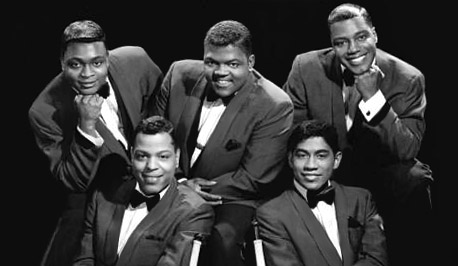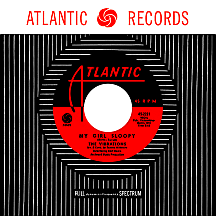THE VIBRATIONS
My Girl Sloopy
Three students attending Dorsey High School in South Los Angeles and two others at nearby Foshay High had one thing in common: singing skills that were a cut above. Tenor James Johnson usually sang lead to Carver Bunkum's bass and the baritone voice of Rene Beard (who was the 16-years-younger brother of Matthew Beard, known to moviegoers as the bowler-hat-wearing "Stymie" in the 1930s Our Gang film shorts). At some point they joined two members of the short-lived Heart Thrills: Carlton Fisher, a second tenor, and Cleo White, who could cover lead or second tenor. It was the beginning of an eventful, everchanging career for the members who stayed for most of The Vibrations' tenure. That name, by the way, wasn't the one the quintet started with.
The Flash Records store on East Vernon Avenue was owned by Charlie Reynolds, whose nickname and the name of the record label he started were the same as the store. The group approached him in the summer of 1955 with a song Fisher had written, "Counting My Teardrops," a deep doo wop tune with a lead vocal by White. It was recorded in October in the back room of the record shop, but the song, credited to The Jayhawks, failed to find an audience. Reynolds wasn't particularly impressed with Johnson's song "Stranded in the Jungle" until one of his sales girls, Ernestine Smith, suggested the unusual escape-from-cannibals narrative be shifted from 'Meanwhile, back in the States' to 'Meanwhile, back in the jungle' with a cartoonish approach. By the time it began climbing the charts in June, a slick cover appeared by crosstown quintet The Cadets, providing strong competition; both were top 20 hits that summer and another version by pop group The Gadabouts reached the top 40. After a third single, "Love Train," the Jayhawks left Flash for Aladdin Records.
Two singles followed in 1957: "Johnnie's House Party" by saxophonist Earl Palmer, featuring "party" sounds by the group, billed as The Jay-Hawks, and sci-fi novelty "The Creature (From Outer Space)" under the same hyphenated spelling of their name. The act's lineup turned over considerably with the departure of Beard, Bunkum and White; tenor Richard Owens, bass Don Bradley and former Heart Thrill, baritone Dave Govan, joined Johnson and Fisher. Two singles for the Allied label, ballad "What's Her Name" and the much wilder "Let the Old Folks Talk" were billed as The Vibes. Two final singles as the Jayhawks appeared in '59 and '60 on Eastman Records: "I Wish the World Owed Me a Living" and "Betty Brown."
Expanding on the Vibes moniker, the group issued its first single as The Vibrations for a short-lived label, Bet; "So Blue," an atmospheric ballad that has been favorably compared to the style of The Flamingos, was picked up by Chess, the beginning of a three-year stint on the Chicago-based company's Checker label. It was a very big hit locally (top ten at AM 560 WIND and two other pop-formatted stations) and made a minor showing on the Billboard charts. They swung back to the novelty side with "Cave Man," which came immediately in the wake of the public's "Alley-Oop" fixation in the summer of 1960. The third Checker disc established them, like it or not, as a dance act; The Watusi" was a top 30 hit in March 1961 (more than a year before the partnerless dance got even bigger with "The Wah-Watusi" by The Orlons).
As another dance tune, "The Junkernoo," was coming out, confusion reigned...but only to anyone paying close attention. The group had done a demo recording of a song penned by The Olympics' crew (producers H.B. Barnum and Marty Cooper and additional songwriters Fred Smith and Cliff Goldsmith); "Peanut Butter," set to the tune of the Olympics' "(Baby) Hully Gully," came off as a zany tribute to the 'sticky, sticky goo' in creamy and chunky varieties. Released on Arvee under the name The Marathons, the record was climbing the charts when the Chess brothers found out and had the guys do a near-identical version, sent out on both Chess and Argo labels with label credits to Vibrations named by others as Marathons or, in some cases, Vibrations recorded as Marathons. In mid-May, during the fourth week of the single's chart run, Billboard listed it on Argo while all other weeks it was shown as Arvee, ultimately reaching the top 20 in late June. Despite having this unexpected hit, the Vibrations never toured or performed under the other name, nor did they have anything to do with three subsequent Marathons singles.
Keeping track of the group became easier as all successive 45s were credited to the Vibrations. Other Chess discs include a remake of "Stranded in the Jungle," done primarily because they were still performing the song in their shows. "Let's Pony Again" briefly jumped on the Don Covay/Chubby Checker bandwagon, "Hamburger on a Bun" served as a beefy equivalent to the "Peanut Butter" hit and "Since I Fell For You" (a strong remake of the 1946 Buddy Johnson tune) was popular in a few east coast markets in early '63, several months before Lenny Welch's rendition became a top ten smash.

When the Checker contract ended, they made some recordings with rising record mogul Bert Berns and his partner, Wes Farrell. Two of these were licensed to Atlantic Records. "Lonesome Little Lonely Girl" (penned by Carl Fisher) has a sweeter sound than earlier efforts, but didn't catch on. The second, on the other hand, is arguably the song the Vibrations are best known for. "My Girl Sloopy," with faux-live sound effects, made its mark at the height of Beatlemania, much of its popularity, perhaps, due to the strangely-named female protagonist who '...lives in very a bad part of town.' The song spread across the country that spring, hitting the top ten in many markets (number two in their L.A. stomping grounds!) and making a respectable top 30 showing nationally (considering the rapidly-increasing British competition). Based on the hit, they signed a deal with Okeh (a recently-reactivated label under Columbia that had already established Major Lance as a hitmaker). Right off the bat, they were doing dance records again. Curtis Mayfield and Okeh president Carl Davis co-produced the first three singles, starting with "Sloop Dance," a blatant attempt at milking the "Sloopy" hit by adding movement to the same melody.
But the impact of "My Girl Sloopy" didn't end there. Vibrations fans within the industry revealed themselves, led by The Yardbirds, whose five and a half minute cover closed their album For Your Love. Toronto, Ontario band Little Caesar and the Consuls took their version to the top ten in Canada and halfway up the U.S. charts in the summer of '65. Berns, whose Bang record label was going strong by that time, took the 'hang on' hook from the song, changing the title to "Hang On Sloopy" and recording it with Indiana band The McCoys; that version hit number one in October. Then The Ramsey Lewis Trio, fresh off their "In Crowd" smash, scored big with a mostly-instrumental, live-in-a-club singalong recording to close out more than a year's worth of "Sloopy" psychoses. Some of the dozens of artists who did covers of the song include Jan and Dean, The Supremes and Count Basie.
The Vibrations settled in at Okeh fdrom 1964 to '68, blending well with label boss Carl Davis's "Chicago Soul" sound under producers Davis, Mayfield, Manny Kellem and Gerald Sims. Several efforts, many of them ballads, saw some measure of success on pop and/or R&B charts: "Keep on Keeping On," "End Up Crying" and fan favorite "Misty" (another great vocal version of Errol Garner's classic) in '65, the Lennon-McCartney gem "And I Love Her" in '66 and "Pick Me" in '67. Rising Philadelphia hotshots Kenny Gamble and Leon Huff took the helm in '68, bringing the group fully into the soul music movement with a smokin' R&B hit, "Love in Them There Hills." Gamble and Huff continued producing the group on Epic and Neptune through 1970.
Owens left in 1971 to join The Temptations and within a few years, after recording for a few smaller labels, the entire group called it quits. Founders James Johnson and Carl Fisher stayed the longest. Looking back, it's easy to see how the odds, overall, tipped in their favor; think of all the R&B vocal combos of the '50s that had to stake their claims-to-fame on just one well-known song. The Vibrations, on the other hand, had four hits under three different names, plus a nice run of well-produced, mildly successful soul singles, all of their output fueling a nearly two-decade series of personal appearances in every corner of the country. Not to mention they started a "Sloopy" obsession that unexpectedly spiraled out of control. Who could ask for anything more?


